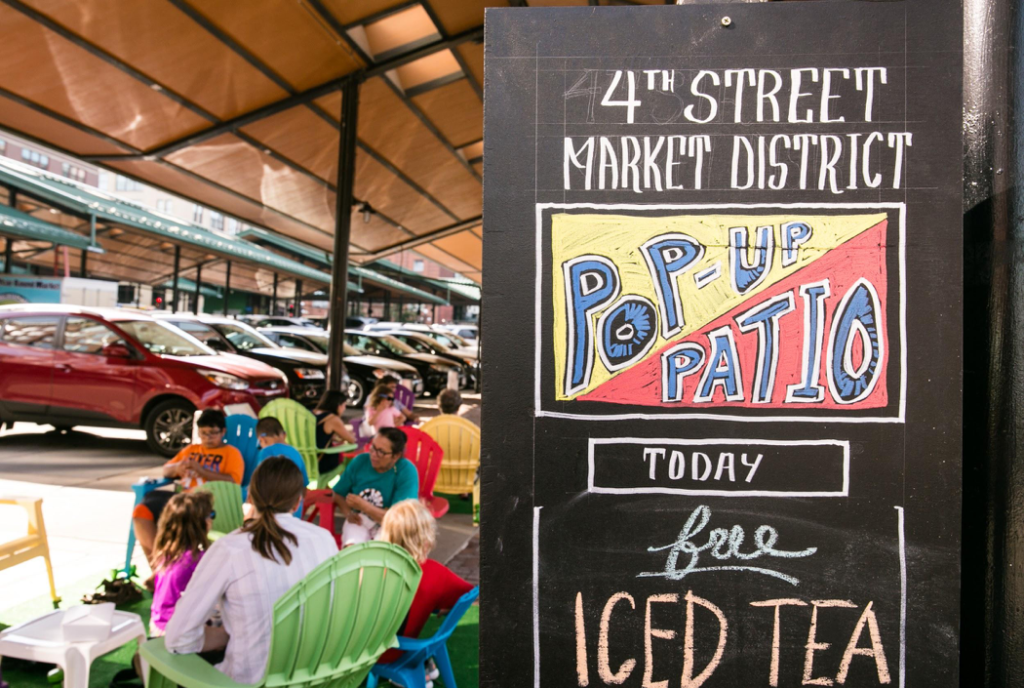Saying “Yes” to 4th Street
In a downtown core experiencing change, the 4th Street Market District partnership leads creative experiments & looks to the future
It was a summer Sunday afternoon in Saint Paul, Minnesota, and from the plaza in front of Union Depot came the sound of drums.
Bomba Umoya, a group that shares and preserves the Puerto Rican music of bomba, was playing, singing, and inviting those gathered to join in. Performer Aiyana Machado explained that in bomba, the dancers lead the drumming — one drum follows their steps, the other keeps the rhythm going. Families circled the plaza and watched the show; curious transit riders getting off the light rail wandered over. As Bomba Umoya’s dancers swayed in long skirts, people of all ages ventured forward to improvise their own steps.
“That’s what bomba is about, that’s what music is,” said Machado. “Community, coming together, singing together, dancing together.”
Bomba Umoya was just one of several groups dancing at Union Depot that day for the 4th Street Boogie. This pop-up dance party was part of a series of pilot projects tried out on the street in June, a “test kitchen” for how art and events can enliven what’s being called the 4th Street Market District.
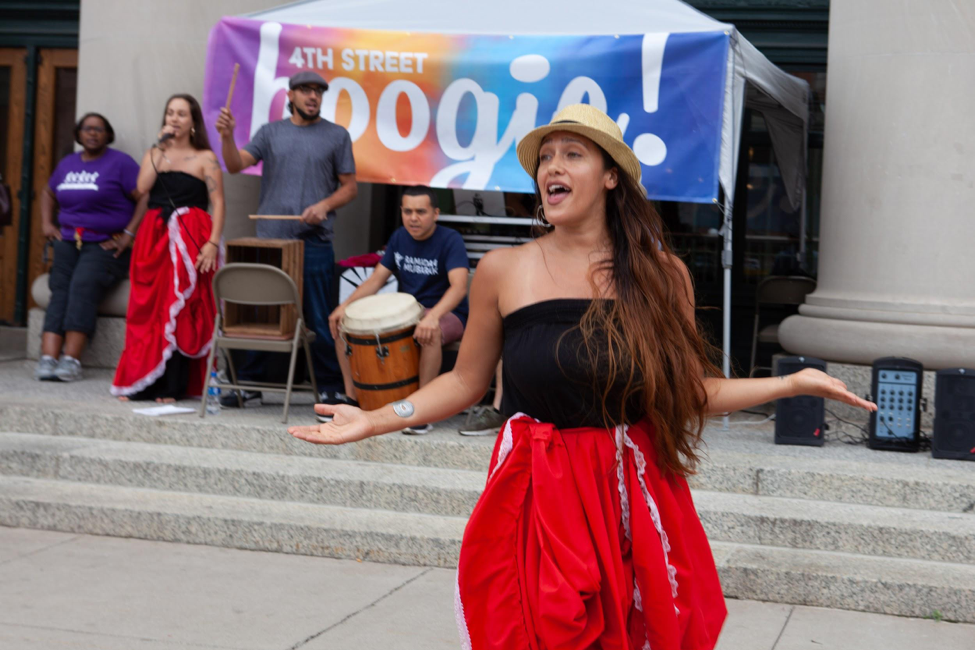
The 4th Street challenge
In recent years, businesses, property owners, and local organizations have pushed to transform 4th Street to be friendlier — more walkable and bikeable, with more public art and retail space. The 4th Street Market District Vision was published in 2015 by a group that included community development nonprofit the Saint Paul Riverfront Corporation. In 2017, the Riverfront Corporation began convening a 4th Street Market District working group, including residents, artists, business owners, and representatives of the street’s anchor institutions, with support from the Knight Foundation, the Bush Foundation, and Saint Paul Cultural STAR.
On one end, those anchors are Union Depot and the Saint Paul Farmers Market. Steps away is CHS Field, home of the minor-league Saint Paul Saints. The neighborhood here is Lowertown, a former warehouse district that became home to many artist studios, galleries, and collectives.
Union Depot is the end of the light rail Green Line, which runs up 4th Street past Twin Cities PBS and the M — formerly known as the Minnesota Museum of Art, currently undergoing renovations in the Pioneer Endicott building. Downtown, 4th Street passes the city hall and county courthouse complex, and ends at Rice Park by Saint Paul Public Library’s central branch, the James J. Hill Center, and the Ordway Center for the Performing Arts.
Especially in Lowertown, 4th Street is a contradiction: It’s one of the city’s major thoroughfares and home to popular destinations, but is a stretch of concrete and asphalt that doesn’t invite much foot traffic or street-level activity.
“You might get a family at the farmers market, and they come around the corner and they want to walk down, but they’re like, ‘Oh honey, I don’t know, that street looks kind of iffy,’” explains Lisa Venticinque, project manager for the 4th Street Market District series of activities.
“That’s the problem we’re trying to solve,” she says, “trying to make it more safe and vibrant without sacrificing its unique individuality, independently run businesses, diverse residents, and strong artist identity.”
To decide how to kickstart activities that would help create the sense of a market district, about 50 invited participants came together this March for a day-long session to share ideas and imagine possibilities. Guest presenters from business associations in Oklahoma City and Santa Ana, California, offered inspiration from successful creative placemaking projects in their cities. The group also walked 4th Street to observe and notice opportunities. Participants discussed their visions for the street, citing values including green space, youth engagement, and recognizing Lowertown’s artists.
Those themes gave rise to three projects for the 4th Street Market District: the 4th Street Boogie, the Chalk Art Street Festival, and the Pop-Up Parklet.
Inviting people in with dance, art, and space to relax
“Do we have any in-house ice packs, Jiffy Lube, anything?” joked DJ Huh? What??, watching Saint Paul dads break it down in the middle of a dance circle.
As emcee and DJ at the 4th Street Boogie on June 10, he was keeping performers and participants moving through a full afternoon of dance: hip-hop and breakdancing with Cypher Side and later the IcyStyles crew, Aztec Mexica Nahua dance with Kalpulli Yaocenoxtli, soul line dancing with Tina Jackson, and flamenco with Sendero Flamenco.
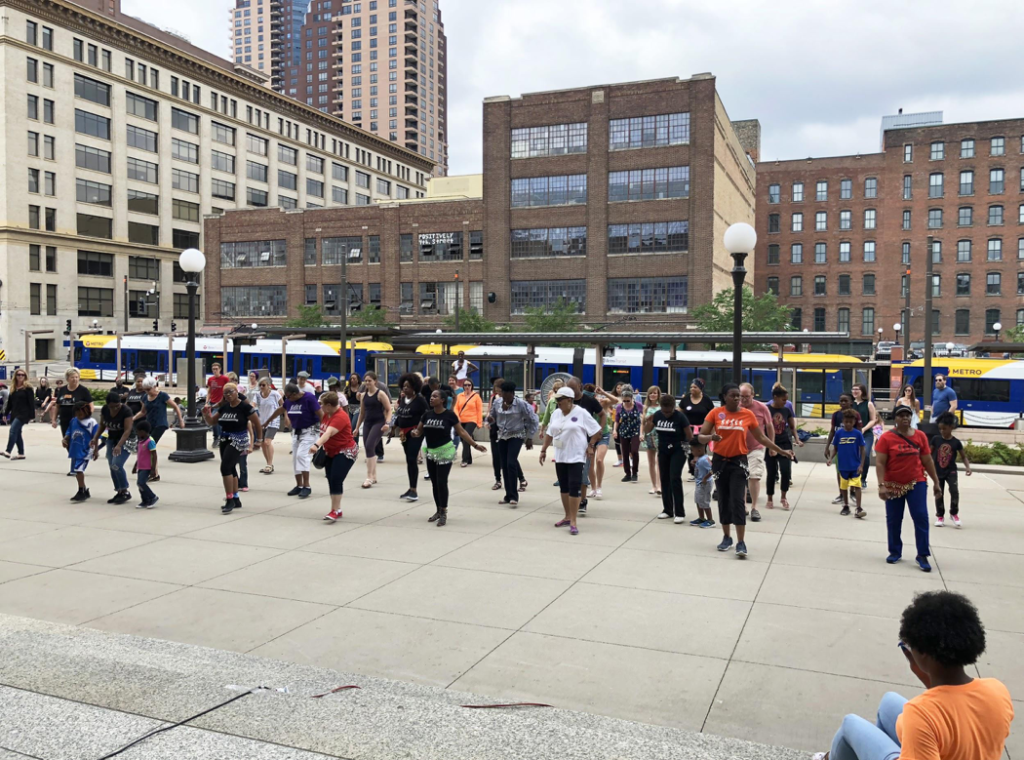
The Boogie was modeled after the World Dance Party, a community event pioneered in Seattle as a way to showcase cultures and connect people through dance. The Saint Paul Public Library had hosted World Dance Party events at some of their branches last year, explains Chase Maxwell, who is the library’s communications and design specialist and helped lead the 4th Street Boogie.
“What’s great about dance is that it brings together people of all ages, and it bridges other divides as well,” Maxwell says. “It’s an engaging art form that’s fun to watch but also fun to participate in.”
Many of the day’s dance groups are active with the Indigenous Roots Cultural Arts Center, which opened in Saint Paul in 2017 as a space for art, wellness, youth development, and social change. The center grew out of the arts and community work of Kalpulli Yaocenoxtli, the Mexica Nahua dance and drum circle that also performed at the 4th Street Boogie.
Several people who attended the Boogie are involved with Indigenous Roots as well. Others learned about the event at the library, in the newspaper, or in the case of one attendee, by Googling “music in Saint Paul.”
The event was planned as a connector for other destinations on 4th Street: It began as the farmers market ended, and wrapped up in time for the evening’s Saints game at CHS Field.
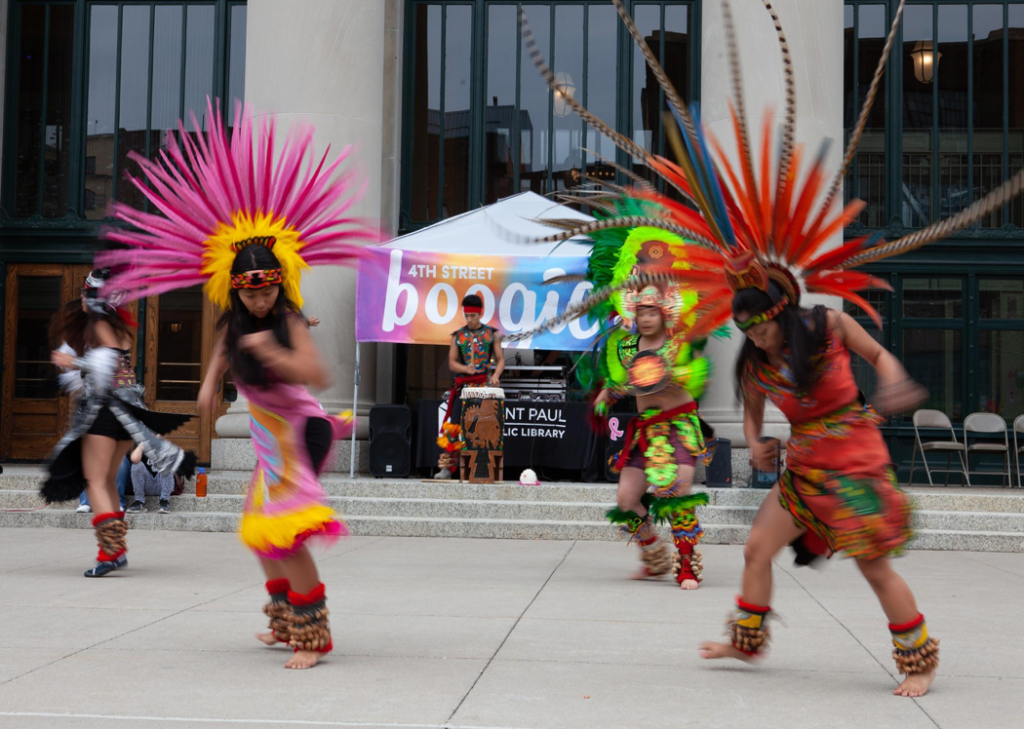
The Pop-Up Parklet was stationed in the Jax Building’s parking lot at 4th and Wacouta during the week of June 18. This self-contained but welcoming wooden structure, lined with greenery, was designed to bring joy to the neighborhood and invite passersby to linger and experience the area in a different way than they would just passing through.
The parklet also hosted live music to coincide with nearby attractions like the Twin Cities Jazz Festival and the farmers market.
“It was a novelty, but it was a functional novelty,” Venticinque says. “A woman walked by and said, ‘I don’t know what it is, but I know I like it.’”
The Chalk Art Street Festival, planned for June 16, was canceled due to thunderstorms. Tabitha Benci DeRango, who helped plan the event, was inspired by a similar event in her former home of in San Rafael, California. The goal was to have artists create pieces honoring local history.
Despite the cancellation, a piece of the event will live on as an interactive installation by Lowertown artist Ta-coumba Aiken. Travelers through Saint Paul’s Central Station will be able to color the piece during a pop-up series there this August through October.
A fourth project, set aside because of timing and logistical constraints, envisioned works by local artists projected onto buildings and surfaces along 4th Street.
Throughout the pilots, it was an asset to have Venticinque as a paid project manager — coordinating permits and other details, scheduling and leading meetings, and keeping the process on track. Because the working group is otherwise volunteer-driven, participants say it will be important to have someone to hold the center going forward.
The pilot projects were a chance for those involved to practice working across “sectors” or “silos” to tackle a problem and share expertise, says Lowertown artist Rachel Wacker, who directs the Saint Paul Saints’ art program. Wacker wrote in an email, “The group got to experience what can be accomplished when residents, small business owners, property owners, and city officials are all in the same room sharing resources.”
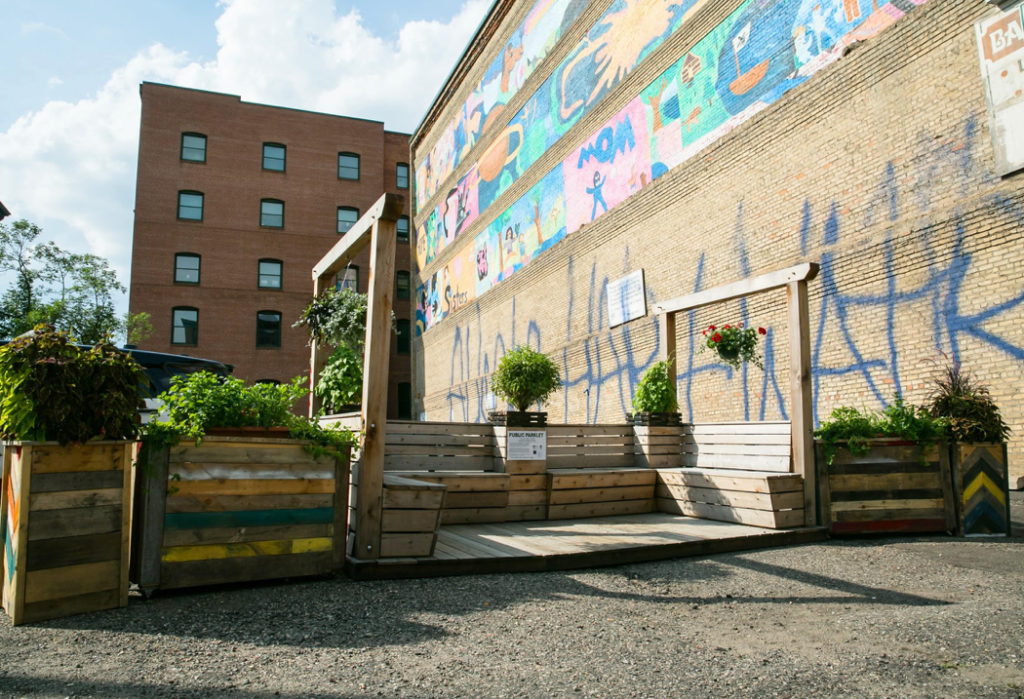
New challenges for what’s next
As the Market District projects came together, the group found themselves at a turning point for this kind of work in Saint Paul. In February, Mayor Melvin Carter and Securian CEO Chris Hilger launched the Saint Paul Downtown Alliance, a coalition of leaders that grew out of conversations led by the Saint Paul Riverfront Corporation about improving the downtown experience.
Then in April, it was announced that the Riverfront Corporation would be closing down after more than 30 years promoting community development along that stretch of the Mississippi.
For the 4th Street Market District working group, there is uncertainty about what comes next, coupled with a strong desire to carry forward what’s been created.
“The 4th Street group has broad community and business support,” said Rich Pakonen of Pak Properties at the same meeting. “It’s critical that this continues to have leadership so it doesn’t end up as a plan on a bookshelf.”
The 4th Street working group will continue to meet, though it remains an open question what their future is as an entity, and what their relationship will be with the Downtown Alliance.
The working group’s collection of engaged volunteers, deep community connections, and proven ability to launch creative projects make the group a valuable asset to leaders eager to improve downtown. Perhaps 4th Street could remain a creative “test kitchen” as part of larger initiatives, and promote more creative pop-ups on the street.
At the same time, the 4th Street working group is wary of watering down its grassroots, creative spirit. That wariness is tied to deeper concerns in Lowertown, a neighborhood whose growth and transition has led to worries that its artists will be driven out. Such worries have been stoked by developments like the Jax Building, which was home to artist studios until being sold in 2016 for conversion into apartments. That spring, locals held a wake in nearby Mears Park for the Jax’s artistic community. Two years later, development hasn’t begun and the vacant building is seen as a blight — one of the reasons the Pop-Up Parklet was placed there.
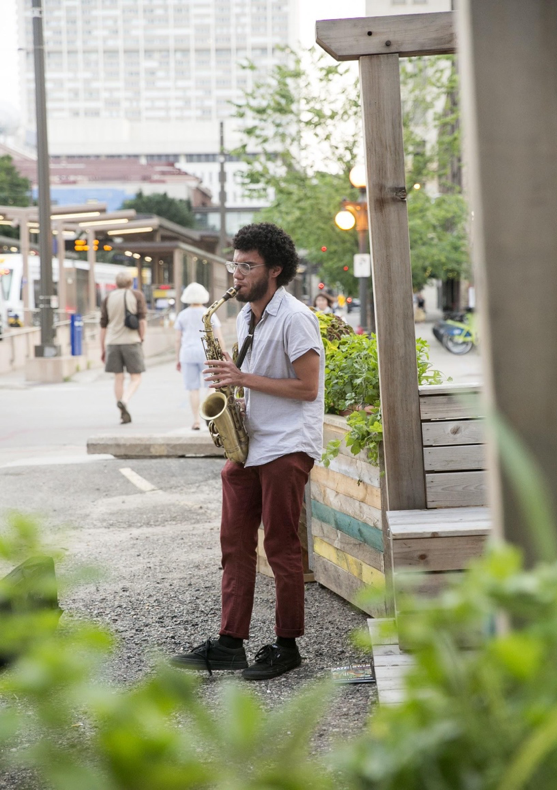
“I want to make sure the artist community is Lowertown is valued,” Tabitha Benci DeRango said at the 4th Street working group’s July meeting. “It’s the reason people want to live here. There have to be advocates for that … putting it out visibly and vibrantly to the whole city, continually showing people that it’s here.”
Rachel Wacker hopes to see artists increasingly involved in future efforts. “Many of them have projects that they have been dreaming for the community, but without support and resources they can’t bring the projects to life,” she wrote of the neighborhood’s artists. Having an established process for inviting and responding to proposals from artists, she says, is one way the 4th Street working group could improve in the future.
Keeping the momentum going
Despite uncertainty, people are still feeling excitement and energy from the pilot projects. The 4th Street group’s work has built important relationships — with the owner of the Jax Building, for example, who agreed to host the Pop-Up Parklet in the building’s lot — and laid the groundwork for potential collaborations to come.
“Something happened here where we got a lot of different people together to make something happen,” Wacker said at a July meeting of the working group. “This is the easiest it’s ever been as an artist organizer to get through the red tape. It’s completely changed my impression of being able to make things happen here.”
The Pop-Up Parklet inspired a Pop-Up Patio with chairs, umbrellas, and astroturf mats outside CHS Field, which Wacker launched through her role with the Saints. The patio is currently being used on CHS Field’s block while it’s closed for construction, but is designed to be a mobile kit that anyone can check out and set up around town.
The Pop-Up Patio is supported by both the 4th Street Market District and the Downtown Alliance, making it an example of how collaboration can continue to happen going forward.
The 4th Street group sees growing support for public art and placemaking from government, business, and property owners. “No”s from a few years ago have changed to “yes”es.
Now, their goal is to make sure that creative initiatives can come from the bottom up, that they’re led by local artists and done with the involvement of residents and small businesses. Though many questions remain, this summer’s pilot projects point to a future of dance, art, cultural celebrations, neighborly conversations, and people being invited to stroll and gather and stay awhile on 4th Street.
